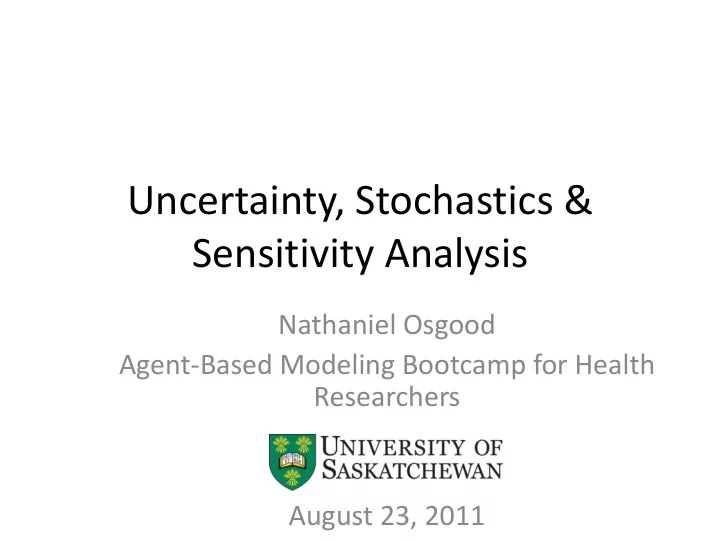

Uncertainty, Stochastics & Sensitivity Analysis Nathaniel Osgood Agent-Based Modeling Bootcamp for Health Researchers August 23, 2011
Types of Sensitivity Analyses • Variables involved • Type of variation – One-way – Single alternative values – Multi-way – Monte Carlo analyses: Draws from probability • Type of component distributions (many types of being varied variations) – Parameter sensitivity • Frequency of variation analysis: Parameter – Static (parameter retains values value all through simulation) – Structural sensitivity – Ongoing change: Stochastic analysis: Examine effects process of model structure on • Accomplished via Monte-Carlo results analyses • Key for DES & ABM
Model Uncertainty • Here, we are frequently examining the impact of changing – Our assumptions about “how the system works” – Our decision of how to abstract the system behaviour • Structural sensitivity analyses – Vary structure of model & see impact on • Results • Tradeoffs between choices – Frequently recalibrate the model in this process • Here, we are considering uncertainty about how the current state is mapped to the next state
Predictor-Corrector Methods: Dealing with an Incomplete Model • Some approaches (e.g. Kalman filter, Particle Filter) are motivated by awareness that models are incomplete • Such approaches try to adjust model state estimates on an ongoing basis, – Given uncertainty about model predictions – New observations • Assumption here is that the error in the model is defined by some probability distribution
Static Uncertainty Sensitivity Analyses • In variation, one can seek to investigate different – Assumptions – Policies • Same relative or absolute uncertainty in different parameters may have hugely different effect on outcomes or decisions • Help identify parameters/initial states that strongly affect – Key model results – Choice between policies • We place more emphasis in parameter estimation & interventions into parameters exhibiting high sensitivity
Spider Diagram • Each axis represents a % change in a particular parameter – This proportional change is identical for the different parameters • The distance assumed by the curve along that axis represents the magnitude of response to that change – Note that these sensitivities will depend on the state of system! http://www.niwotridge.com/images/BLOGImages/SpiderDiagram.jpg
Systematic Examination of Policies Sum of Total QALYs 350000 300000 250000 200000 150000 100000 50000 0 08-13 Female 14-18 19-24 25-34 35-44 45-54 Uptake 55-64 65+ Relapse 08-13 14-18 19-24 Male Cessation 25-34 35-44 45-54 55-64 65+ Tengs, Osgood, Lin
Add New “Parameters Variation” Experiment
Setting Ranges for Parameter Variation Can Handle 1-Way or (Orthogonal) Multi-Way
Sensitivity Exploration in AnyLogic Performing 1 Way Sensitivity (for now…)
Monte Carlo Analyses in AnyLogic: Specifying Distributions for Parameters
Monte Carlo Output After Some Runs
Monte Carlo Output After All Runs
Sensitivity in Initial States • Frequently we don’t know the exact state of the system at a certain point in time • A very useful type of sensitivity analysis is to vary the initial model state • In Aggregate models, this can be accomplished by – Varying the number of people in the stock via a parameter to adjust • In an agent-based model, state has far larger dimensionality – Can modify different numbers of people with characteristic, location of people with characteristic, etc.
Imposing a Probability Distribution Monte Carlo Analysis • We feed in probability distributions to reflect our uncertainty about one or more parameters • The model is run many, many times (realizations) – For each realization, the model uses a different draw from those probability distribution • What emerges is resulting probability distribution for model outputs
Multi-Way Sensitivity Analyses • When examining the results of changing multiple variables, need to consider how multiple variables vary together • If this covariation reflects dependence on some underlying factor, may be able to simulate uncertainty in underlying factor
Recommend
More recommend